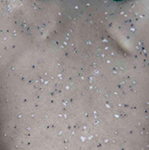A chameleon virus: EBV-induced PLEVA-like eruption in a child with neuroblastoma.

Downloads
DOI:
https://doi.org/10.26326/2281-9649.35.4.2842How to Cite
Abstract
Cutaneous eruptions in pediatric oncology may arise as secondary effects of chemotherapy, infections, or the tumor itself (paraneoplastic eruptions); Epstein–Barr virus (EBV) reactivation is a less well-known cause. EBV usually persists in a latent form, but in immunocompromised hosts it can induce either reactive or cytopathic cutaneous lesions. EBV-induced PLEVA-like eruptions are extremely rare, especially in children with cancer. We report the case of a 5-year-old boy with cervical neuroblastoma undergoing chemotherapy who developed sequential polymorphic lesions. The initial papulovesicular lesions mimicked varicella but proved resistant to acyclovir. Subsequently, verrucous lesions appeared, resembling epidermodysplasia verruciformis or generalized verrucosis, although HPV studies were negative. Later, papulonecrotic lesions, clinically resembling PLEVA, demonstrated EBV DNA and focal immunohistochemical positivity for LMP1. Taken together, these findings established the diagnosis of an EBV-induced PLEVA-like eruption, likely favored by immunosuppression. This case highlights the potential of EBV to induce atypical and recalcitrant eruptions in pediatric oncology, underscoring the importance of clinico-pathological correlation and molecular confirmation for accurate diagnosis.
